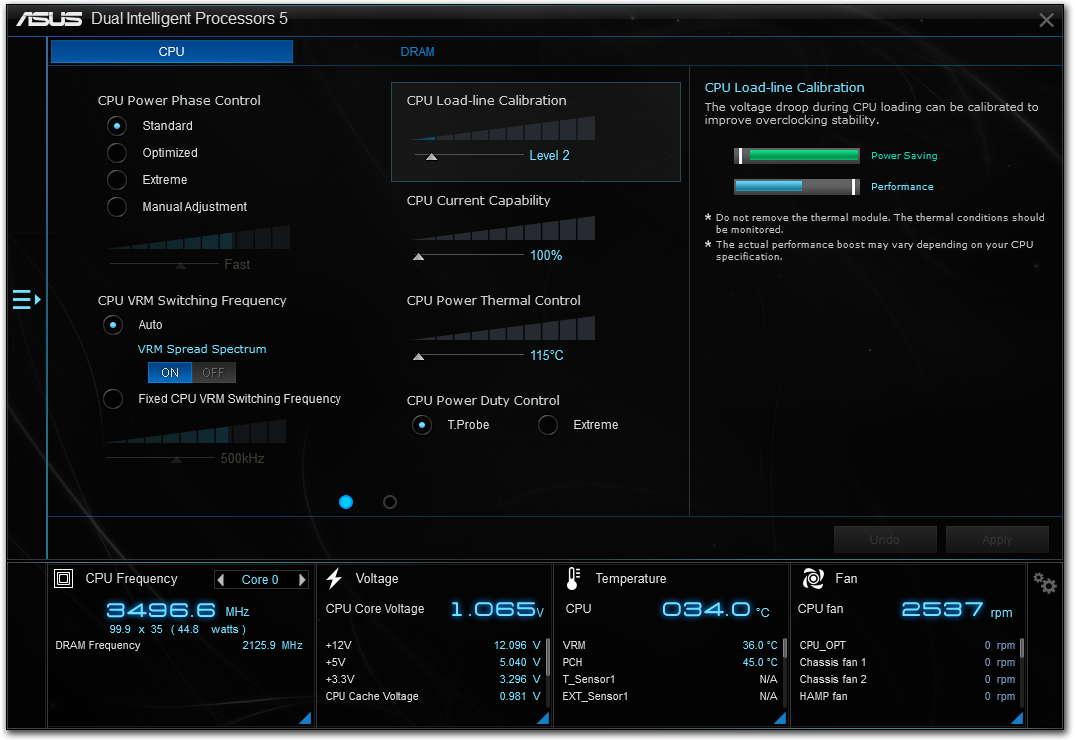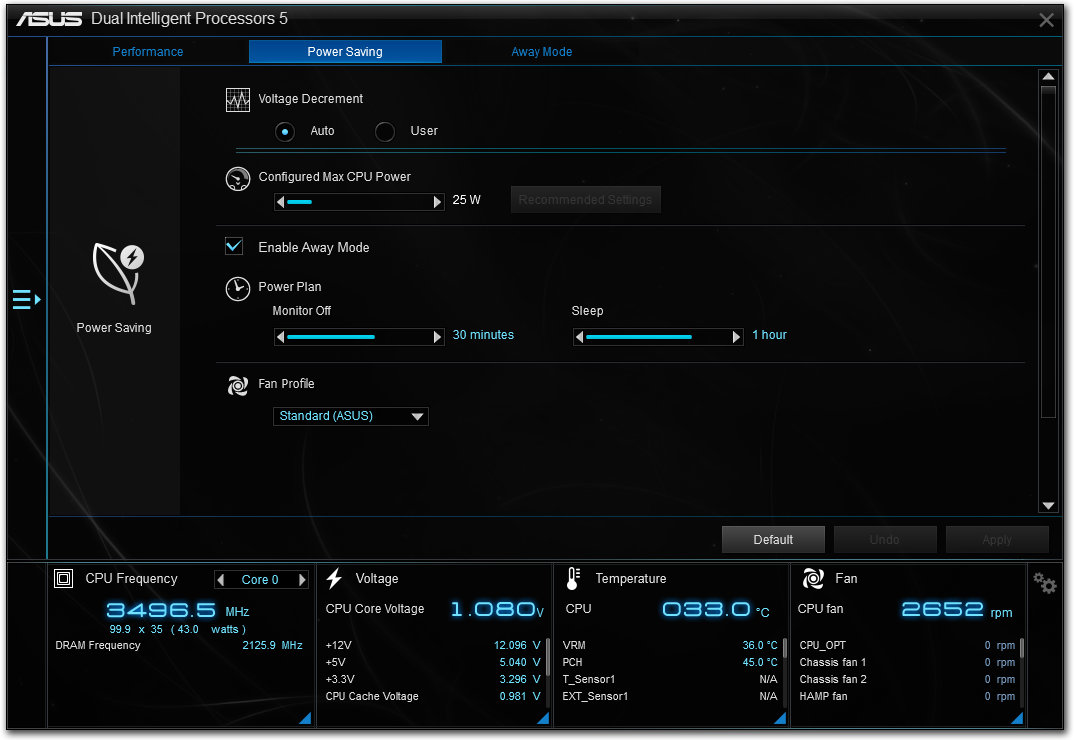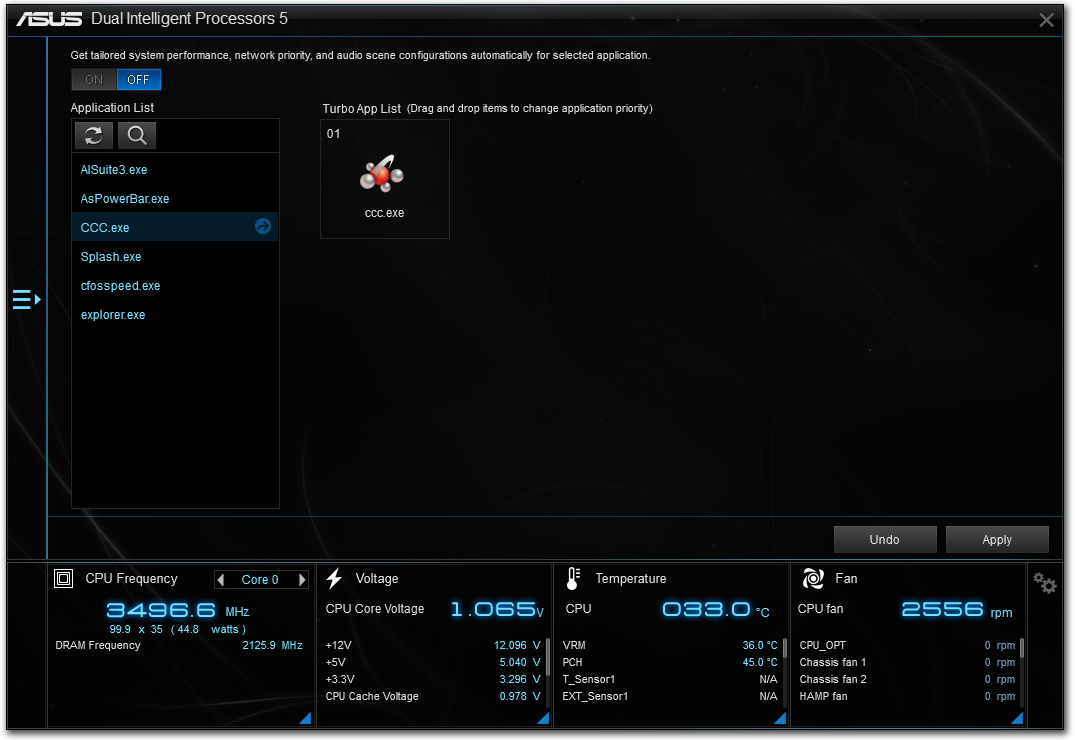The ASUS X99-E-10G WS Motherboard Review: 10GBase-T Networking with Intel’s X550-AT2
by Ian Cutress on November 7, 2016 9:00 AM EST- Posted in
- Motherboards
- Intel
- Asus
- 10G Ethernet
- X99
- 10GBase-T
- X99-E-10G WS
- X550
- X550-AT2
ASUS X99-E-10G WS Software
Part of this Software overview mirrors that of our ASUS X99-A review and recent 100-series reviews due to the extreme similarity in options, aesthetics and features.
The software stack comes under the AI Suite 3 naming convention, where ASUS’ main play in this area comes from the Dual Intelligent Processors 5 (DIP5) interface. The dual intelligent processors part refers to the onboard EPU and TPU ICs which are an ASUS custom designed IC for monitoring and adjusting both the energy and turbo parts of the system. The 5 at the end of the name refers to both the version and the number of sub-apps within the DIP5 interface.
The five sub-apps are the TPU, Fan Xpert, DIGI+ Power Control, EPU and Turbo App. Alongside these is the 5-Way Optimization option that provides a series of settings to help users perform automatic overclocking.
The TPU part of DIP5 offers the CPU overclock settings for ratios, base frequencies, and voltages in terms of offsets and base values. The graphs showing how the voltage adjusts with the CPU ratio are nice touches as they provide direct feedback to the user based on what they are changing.
The fan settings allow users to apply a bulk fan mode to all the fans or go in and adjust them manually. The Fan Tuning button on the left provides a way for the system to analyze the characteristics of each fan attached by applying different fan power levels and measuring the RPM.
The digital power controls are for enthusiasts willing to push the system a little further. The automatic overclock options also adjust these settings slightly, giving extra CPU load-line calibration or placing the power phases into extreme performance mode. There are digital power options for both the CPU and the DRAM on hand.
The EPU part of AI Suite allows the user to adjust what is enabled when the system is in a low power mode. This includes a target power consumption for the CPU by reducing clocks and voltage, but also by disabling fast-charging USB ports and turning down CPU fan speeds.
The final part of 5WO is Turbo App, which is the newest addition to the interface. This allows the user to adjust overclocks and settings depending on what software is currently loaded. This means for a linear workload, a user can have the fans turned down but the single thread speed high, or when a game is played we have a full-core overclock with fast fans and LAN priority for the game in question:
The interface allows each program to be adjusted for importance, so if two software packages are opened and both have a Turbo App profile, the settings of the more important one will take precedence.
The rest of AI Suite is similar to previous generations on the mainstream platform:
Ai Charger: Gives USB 3.0 charging to BC1.1 compliant devices.
USB 3.1 Boost: Gives a Turbo mode to compatible USB devices.
EZ Update: Online updating software, although still has issues.
System Information
USB BIOS Flashback:Arrange a USB for BIOS Flashback.
USB Charger: Allows charging from certain USB ports in sleep, hibernate or shutdown mode.
Push Notice: Synchronize a tablet or smartphone to receive notifications if system parameters (temperature, fan controls) go beyond a specified range.
One element of the software is TurboLAN, which is a reskinned version of cFos that implements software priority over the network:
ASUS has preinstalled settings for VoIP, Media, Games or File Sharing, although users can adjust these as required.
One point I would like to request from ASUS is for the Update software to receive an update. As far as it has been part of the ASUS software ecosystem, from the UK it has only ever worked once for me. This is a system that MSI had solved a while ago, with ASRock and GIGABYTE implementing their own systems that work. ASUS is still far behind in this regard.
The software package also comes with CPU-Z in order to identify the system:
As well as Boot Setting to allow for easy entry into the BIOS or enabling Fast Boot modes:












 Webstorage_thumb.png)
 Boot Setting_thumb.png)
 Aura_thumb.png)
 Turbo LAN_thumb.png)
 Turbo LAN_thumb.png)
 CPUz_thumb.png)








63 Comments
View All Comments
kgardas - Tuesday, November 8, 2016 - link
Looks really nice, ~6W for 10Gbit is good and very low on todays standard. The only drawback in comparison with Intel is PCIe 2.0 support only, so for 10Gbit you need 4 PCIe lanes. Otherwise I'm looking forward to see this card here...Notmyusualid - Friday, December 2, 2016 - link
@ kgardas: You should have seen our 10G DWDM telecom equipment, back in late 1998... more than 6W I can tell you :) , in fact we couldn't get it to work without forced air, each transceiver taking up a whole rack shelf, and we could only fit three shelves / rack space. The electrical complexity / number of boards to make it work was astounding.Incredible to see it done on a single card now, and more often now, even multiples of, on a single card.
So yes, tech moves on...
Lolimaster - Tuesday, November 8, 2016 - link
I think you should dive the PSU's used.Only a high wattage for multigpu test (850w+)
500-650w Titanium for any cpu + single gpu / APU-intel IGP powered systems
ads295 - Wednesday, November 9, 2016 - link
You know how those clickbait websites show cleavage or a$$?The thumbnail for this article led me to open it in the same vein. :O
Breit - Thursday, November 10, 2016 - link
Thanks for this review Ian, very informative.While reading the comments here, the single feature that seems to attract the most attention is the inclusion of 10G Ethernet. As it seems rather hard to implement a good performing 10G network compared to 1G, maybe an AnandTech-style in-depth article about 10G networking in general would be appreciated by the readers of this site. Just a suggestion.
At least I would appreciate it... ;)
JlHADJOE - Friday, November 11, 2016 - link
Didn't think I'd see the day when an ASUS motherboard is both cheaper and has more features than it's ASRock counterpart.Notmyusualid - Friday, December 2, 2016 - link
More features?I don't see a SATA DOM port.
It is missing 2x 1GB Ethernet ports.
It is missing 2 SATA ports (12 vs 10)
It has only 10-phase power solution, vs 12 phase.
It has no USB 2.0 ports did I read correctly?
It has no fan on the 10G heatsink also, which allows the case temp to equalize with outside temps for some time after shutdown, to avoid condonsation building up in the case.
Can you mount the same range of M.2 SSDs in this? I see only two mounting holes, mine has four...
Board-mounted USB port, for DRM-related stick, or whatever you need connecting / secured on the INSIDE of a case.
I also believe I have LAN LED headers to put network activity on the front panel, as one does with their hard disks.
So tell me if I'm wrong, please.
One thing I'll say, I do find the 6-pin board power connector much more elegant than my 4-pin Molex connector. And I cannot STAND my anodized blue... the black on the ASUS is also more elegant.
Anybody who needs their pcie slots lit, to choose the right combo shouldn't be allowed to buy it..
Notmyusualid - Friday, December 2, 2016 - link
also @ JihadjoeMine has TB header too. Almost forgot about that...
Hixbot - Tuesday, November 22, 2016 - link
Don't understand the move to 10G copper. We should be transitioning towards 10G fiber. Copper can't carry 10G a practical distance. 55 meters for unshielded Cat 6 cable. That't not very far. 100 meters for shielded Cat 6, thats more reasonable. but has anyone priced Cat 6 shielded cable? It's very expensive, and good luck terminating the shielded RJ45 yourself to Cat 6 standards. In my workplace, we've had to order pre-terminated lengths of shielded Cat 6. Whenever we use fiber it's easier to terminate, costs are much cheaper, and distance is practically unlimited.So what is with the move to 10G copper?
Notmyusualid - Friday, December 2, 2016 - link
As an owner of the asrock, I too would have preferred SFP sockets.But SMBs CAN afford $700 for a switch, and many of them have little fiber. My 2c.